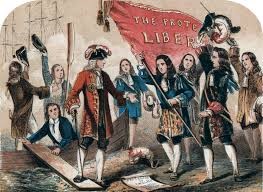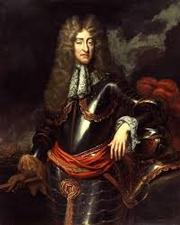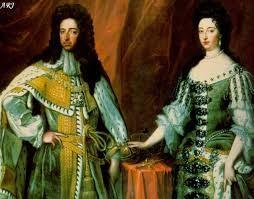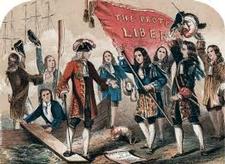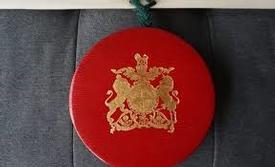The United Kingdom is officially a Protestant country. The Queen heads the Protestant Church of England, all monarchs since 1689 have been Protestant and all 77 Prime Ministers have been Protestants of some form. Despite recent secular trends, Protestantism remains the established creed of the land. But why is this the case? Did everyone collectively decide one day to abandon the old Catholic religion and agree that Protestantism was the way forward?
The simple answer is no. The UK has a long and painful history of religious conflict and even today is home to a sizeable Catholic minority. The story of why this minority was barred – either by law or by custom – from holding official positions has its roots in a struggle that began with the ascension of a Catholic King and resulted in Parliament welcoming a foreign Protestant monarch. It is a story of the last successful invasion of Britain, one which firmly established the new faith as the dominant faith, one which led to the countries of the British isles forming a United Kingdom and one which left a legacy of violence and bigotry that lasts to this day.
From Reformation to Revolution
It is well known that Henry VIII broke England’s allegiance to Rome in 1534 and established the Church of England with the monarch as its head. It is therefore a common assumption that the English state was firmly Protestant from this point forward, but this does not give proper due to the complexity and nuance of religious power in England in the 16th and 17th Centuries. The truth is that English governments were religiously diverse for more than a century after Henry VIII’s reformation: Henry himself remained a Catholic despite his break with Rome, his daughter Mary I re-established the Catholic faith for a spell in the 1550s, the first Stuart King James I had a complex attitude to Catholicism and allowed open Catholics to serve on his privy council, King Charles I was married to a Catholic, and King Charles II was suspected of harbouring Catholic sympathies. All of this brings us to 1685, when Charles II is lying on his deathbed and is widely rumoured to have secretly converted to Catholicism before he passed. Though England was officially Protestant and attending Catholic mass was still illegal, Catholicism still had an influence in the affairs of the English state.
James II was a committed Catholic
Charles II had several illegitimate children owing to his infamous appetite for mistresses, but no children with his wife. Therefore, the next person in line to the English throne was his younger brother James. James possessed Charles’ height and domineering physical presence but did not possess his easy charm and ability to be liked. Instead, he inherited the stubbornness and narrow mindset of his father, Charles I, whose failings had cost him his crown and his head less than 40 years previously. But there was another, far greater, problem with James: he was a Catholic. Not only was he Catholic, but he had ties to France and had a history of defying the anti-Catholic laws passed by Parliament in the previous decades.
It is difficult to convey to the modern mind how terrified English Protestants were of being ruled by a Catholic. As described by Edward Vallance, Catholicism was seen as a tyrannical religion whose followers owed their allegiance to the Pope before any country. In a world where people on both sides of the religious divide had been brought up with hysterical tales of how depraved the other side were, the fear of being no more than a vassal state of Rome was palpable.
English Protestants were deeply sceptical of the new King when he was crowned as James II in February 1685 but were initially willing to tolerate him. After all, he was unquestionably the rightful King and promised to honour the existing religious situation in England. Crucially, his only children were two daughters, Mary and Anne, who were both firmly Protestant. At the age of 51, it was considered unlikely that James would have any more children and many Protestants decided they could make their peace with the brief reign of a Catholic King since Mary, who was married to the Protestant leader of the Dutch, William of Orange, would be next in line.
William and Mary
However, James quickly started to overreach himself. Always a vocal opponent of the Test Act of 1673, which had barred Catholics from holding public office, he tried to exempt certain Catholic individuals from these barriers and place them in important government and military positions. This was resisted by Parliament, which James dissolved in November 1685. He decided he would try and rule on his own, and in doing so was repeating the mistakes of his father Charles I and his grandfather James I, who had both tried the exact same move and found it fruitless. James persevered, and in 1687 issued a Declaration of Indulgence that would suspend the legal persecution of Catholics and Protestant dissenters. He was alienating the powerful and the public alike, and hurtling towards disaster.
The moment that sealed James’ fate was also one of immense personal happiness. On 10th June 1688, James’ second wife Mary of Modena gave birth to a baby boy, James Francis Edward Stuart. It was a bitter blow for English Protestants, who now knew that the King’s daughter Mary would no longer come to the throne since the law dictated that a son of the monarch would leapfrog any older sisters in the line of succession. The blow was made worse when James announced that his son would be raised a Catholic. Rumours spread that the baby was not legitimate, that he had been taken from somewhere else and delivered to the Royal couple. Many Protestants lapped these stories up, but wiser ones knew that the rumours were not true and would never be enough to prevent the baby from being the rightful heir. With no natural end to Catholic rule in sight, seven English peers made contact with Mary and her husband.
The Orange Invasion
William of Orange arrives on English shores
Mary and William needed no encouragement to take the throne of England. Not only did they consider it Mary’s birth right, but they also saw the value in having control of England for their war against France, rather than allowing James, with his well-known French sympathies, to remain on the throne. In drizzly autumn rain on 5th November 1688, William landed in Devon with 35,000 Dutch soldiers. Rather than having to fight their way on shore, some local people welcomed them warmly while others were simply indifferent about the Dutch invasion; not everyone wanted to rebel against their King, but no one wanted to fight to protect him. The Dutch army experienced similar welcomes as they moved through the English west country towards London.
Meanwhile, James II was in disarray. According to Terry Stewart, he had been suffering from terrible nosebleeds through the year and his fleet had been prevented from intercepting William’s by the same wind that had carried the Dutch to England, so he was already wallowing in self-pity. He tried to muster a royal army to fight the invaders, but found that many of his military officers, unhappy at the promotion of Catholics in the previous few years, were defecting to the Dutch. Worse still, his other daughter Anne had already headed west to join the invading army. He managed to gather a small force to meet William at Reading on 7th December but was comfortably defeated. Realising the game was up, his wife and son fled for France. James tried to flee the following day but was caught by some fishermen in Kent and returned to London, despite the fact that he had thrown the Royal Seal into the Thames in an effort to disguise himself. This discarding of the seal, without which no Royal permission could be given to anything, was incredibly symbolic and gave extra legitimacy to the Protestant cause. Although they were unhappy with James’ rule many Protestants were still wary about open rebellion against him, as the belief at the time was that a monarch was chosen to rule by God. However, if James himself had thrown the Royal Seal into the river, then he was forfeiting his right to rule.
James II discarded the Royal Seal in the Thames
William received word that James was imprisoned in London but realised that this would present a problem. He knew that James’ continued presence in London would always mean there was potential for rebellion, yet he also knew that he would be considered a tyrant and a murderer if he had James killed. Instead, William wanted James to flee abroad, so that he could show the English people that their King had abandoned them but more importantly so that the question of what to do with him was taken out of his hands. He sent word to Dutch guards in London to secretly let James escape to France, and the old King jumped at the opportunity.
William and Mary arrived in London on 18th December 1688, a few days after James had escaped. One of their first acts was to accept the Declaration of Rights, now known as the Bill of Rights, which secured regular Parliaments, free elections (though limited suffrage) and the prohibition of Catholics holding public office. Upon accepting the declaration, William and Mary were crowned King and Queen of England on 11th April 1689, and of Scotland the following month. Both nations, who would be joined officially less than 20 years later, were now firmly Protestant and had enshrined anti-Catholic laws.
Aftermath and Legacy
James did not relinquish his claim to the throne and attempted to take it back, but all his advances were repelled. William’s final victory over James’ forces came at the Battle of the Boyne, north of Dublin, in July 1690. It is this victory which leads neatly into a discussion of the mixed legacy of ‘Glorious’ revolution. To this day, Protestants in Northern Ireland and beyond celebrate the defeat of the Catholics with parades on 12th July, led by the ‘Orange order’. The celebration occasionally slips into barely disguised anti-Catholic sentiment, which is reflective of the fact that this was a revolution born out of anti-Catholic bigotry more than anything else, and the scars it produced have never fully healed. Indeed, it was only in 2015 that restrictions on a British monarch being married to a Catholic were lifted, and a Catholic still cannot lawfully become King or Queen of Britain.
James died in France in 1701, but his descendants claimed to be the rightful heirs to the throne for decades after. The most famous example of this was his grandson Charles, better known as Bonnie Prince Charlie, who landed in the Scottish Highlands in July 1745 only to suffer a disastrous defeat at the hands of the British army at Culloden later that year. That defeat marked the end of the Stuart claims to the throne and secured the reign of the Hanoverians, who had been invited to sit on the British throne after the death of Queen Anne in 1714: Both of King James’ Protestant daughters had died heirless, and Parliament had picked their obscure German relations to take the throne instead of their Catholic half-brother.
The revolution did also leave a more positive legacy than bigotry and bloodshed. The Declaration of Rights that William and Mary recognised paved the way for a constitutional monarchy, as the power of Parliament strengthened and that of the monarchy waned. This was particularly the case once the first Hanoverian King, George I, came to power, as he could not speak English and left much authority in the hands of his ministers – led by the Prime Minister – while he spent most of his time in his German homeland. In a strange sense, then, that fierce anti-Catholic sentiment which limited the freedoms of so many citizens inadvertently led to Britain becoming a more progressive country.
Calling the revolution of 1688 the ‘glorious’ revolution does feel dubious, but it is certainly no exaggeration to say that it had a mighty hand in forming the United Kingdom as it is today. If a descriptive word has to be used then it may be better to use the word ‘incredible’, as suggested by some historians. Never again would a monarch try to so openly defy the wishes of Parliament and the people.
Acknowledgements
The Ministry of History is not an academic source. Our pieces are written by writers who have been studying history for years and are well versed in, and influenced by, countless other writers and works. For this article specifically our sources have included:
'The Glorious Revolution', article by Edward Vallance, published by BBC History (2017)
'The Glorious Revolution 1688', article published by Terry Stewart, published by historic-uk.com
'The Glorious Revolution', article published by parliament.uk
Images
Image one - britannica.com
Image two - schoolhistory.co.uk
Image three - artemisiasroyalden.wordpress.com
Image four - royalcentral.co.uk

